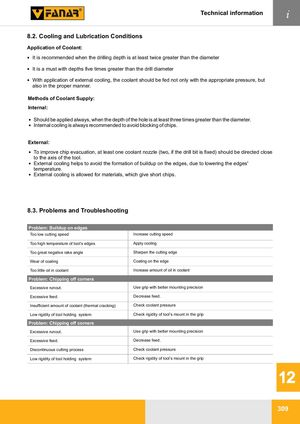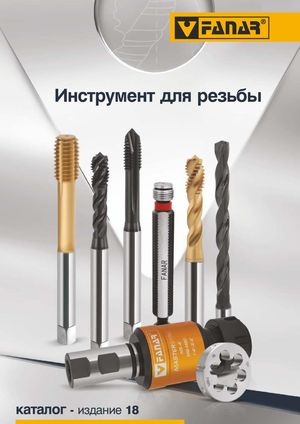Общий каталог FANAR 2021 - страница 312
Навигация

Technical information i 8.2. Cooling and Lubrication Conditions Application of Coolant: — It is recommended when the drilling depth is at least twice greater than the diameter — It is a must with depths five times greater than the drill diameter — With application of external cooling, the coolant should be fed not only with the appropriate pressure, but also in the proper manner. Methods of Coolant Supply: Internal: — Should be applied always, when the depth of the hole is at least three times greater than the diameter. — Internal cooling is always recommended to avoid blocking of chips. External: — To improve chip evacuation, at least one coolant nozzle (two, if the drill bit is fixed) should be directed close to the axis of the tool. — External cooling helps to avoid the formation of buildup on the edges, due to lowering the edges' temperature. — External cooling is allowed for materials, which give short chips. 8.3. Problems and Troubleshooting Problem: Buildup on edges Too low cutting speed Increase cutting speed Too high temperature of tool’s edges Apply cooling Too great negative rake angle Sharpen the cutting edge Wear of coating Coating on the edge Too little oil in coolant Increase amount of oil in coolant Problem: Chipping off corners Excessive runout. Use grip with better mounting precision Excessive feed. Decrease feed. Insufficient amount of coolant (thermal cracking) Check coolant pressure Low rigidity of tool holding system Check rigidity of tool’s mount in the grip Problem: Chipping off corners Excessive runout. Use grip with better mounting precision Excessive feed. Decrease feed. Discontinuous cutting process Check coolant pressure Low rigidity of tool holding system Check rigidity of tool’s mount in the grip 12 309
 Общий каталог FANAR 2018
Общий каталог FANAR 2018 Каталог FANAR цельные твердосплавные фрезы
Каталог FANAR цельные твердосплавные фрезы